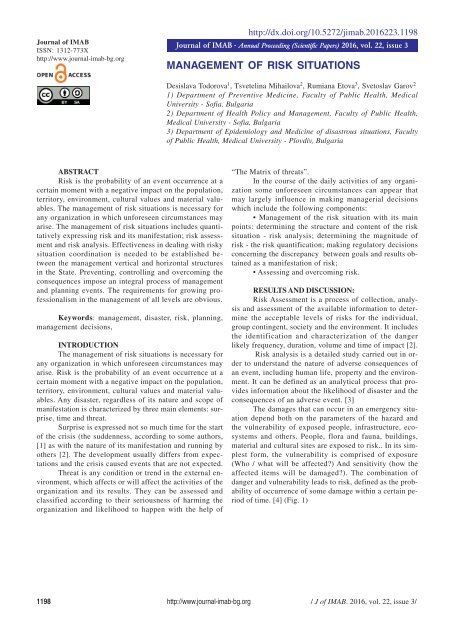JofIMAB-2016-vol22-issue3
Create successful ePaper yourself
Turn your PDF publications into a flip-book with our unique Google optimized e-Paper software.
Journal of IMAB<br />
ISSN: 1312-773X<br />
http://www.journal-imab-bg.org<br />
http://dx.doi.org/10.5272/jimab.<strong>2016</strong>223.1198<br />
Journal of IMAB - Annual Proceeding (Scientific Papers) <strong>2016</strong>, vol. 22, issue 3<br />
MANAGEMENT OF RISK SITUATIONS<br />
Desislava Todorova 1 , Tsvetelina Mihailova 2 , Rumiana Etova 3 , Svetoslav Garov 2<br />
1) Department of Preventive Medicine, Faculty of Public Health, Medical<br />
University - Sofia, Bulgaria<br />
2) Department of Health Policy and Management, Faculty of Public Health,<br />
Medical University - Sofia, Bulgaria<br />
3) Department of Epidemiology and Medicine of disastrous situations, Faculty<br />
of Public Health, Medical University - Plovdiv, Bulgaria<br />
ABSTRACT<br />
Risk is the probability of an event occurrence at a<br />
certain moment with a negative impact on the population,<br />
territory, environment, cultural values and material valuables.<br />
The management of risk situations is necessary for<br />
any organization in which unforeseen circumstances may<br />
arise. The management of risk situations includes quantitatively<br />
expressing risk and its manifestation; risk assessment<br />
and risk analysis. Effectiveness in dealing with risky<br />
situation coordination is needed to be established between<br />
the management vertical and horizontal structures<br />
in the State. Preventing, controlling and overcoming the<br />
consequences impose an integral process of management<br />
and planning events. The requirements for growing professionalism<br />
in the management of all levels are obvious.<br />
Keywords: management, disaster, risk, planning,<br />
management decisions,<br />
INTRODUCTION<br />
The management of risk situations is necessary for<br />
any organization in which unforeseen circumstances may<br />
arise. Risk is the probability of an event occurrence at a<br />
certain moment with a negative impact on the population,<br />
territory, environment, cultural values and material valuables.<br />
Any disaster, regardless of its nature and scope of<br />
manifestation is characterized by three main elements: surprise,<br />
time and threat.<br />
Surprise is expressed not so much time for the start<br />
of the crisis (the suddenness, according to some authors,<br />
[1] as with the nature of its manifestation and running by<br />
others [2]. The development usually differs from expectations<br />
and the crisis caused events that are not expected.<br />
Threat is any condition or trend in the external environment,<br />
which affects or will affect the activities of the<br />
organization and its results. They can be assessed and<br />
classified according to their seriousness of harming the<br />
organization and likelihood to happen with the help of<br />
“The Matrix of threats”.<br />
In the course of the daily activities of any organization<br />
some unforeseen circumstances can appear that<br />
may largely influence in making managerial decisions<br />
which include the following components:<br />
• Management of the risk situation with its main<br />
points: determining the structure and content of the risk<br />
situation - risk analysis; determining the magnitude of<br />
risk - the risk quantification; making regulatory decisions<br />
concerning the discrepancy between goals and results obtained<br />
as a manifestation of risk;<br />
• Assessing and overcoming risk.<br />
RESULTS AND DISCUSSION:<br />
Risk Assessment is a process of collection, analysis<br />
and assessment of the available information to determine<br />
the acceptable levels of risks for the individual,<br />
group contingent, society and the environment. It includes<br />
the identification and characterization of the danger<br />
likely frequency, duration, volume and time of impact [2].<br />
Risk analysis is a detailed study carried out in order<br />
to understand the nature of adverse consequences of<br />
an event, including human life, property and the environment.<br />
It can be defined as an analytical process that provides<br />
information about the likelihood of disaster and the<br />
consequences of an adverse event. [3]<br />
The damages that can occur in an emergency situation<br />
depend both on the parameters of the hazard and<br />
the vulnerability of exposed people, infrastructure, ecosystems<br />
and others. People, flora and fauna, buildings,<br />
material and cultural sites are exposed to risk.. In its simplest<br />
form, the vulnerability is comprised of exposure<br />
(Who / what will be affected?) And sensitivity (how the<br />
affected items will be damaged?). The combination of<br />
danger and vulnerability leads to risk, defined as the probability<br />
of occurrence of some damage within a certain period<br />
of time. [4] (Fig. 1)<br />
1198 http://www.journal-imab-bg.org / J of IMAB. <strong>2016</strong>, vol. 22, issue 3/



